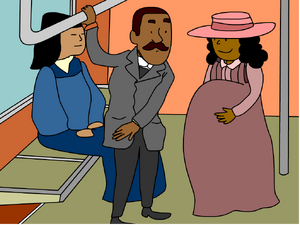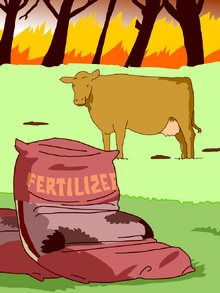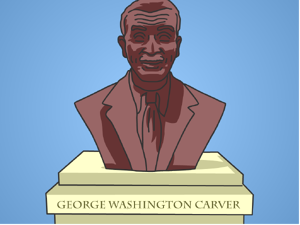| George Washington Carver | |||
|---|---|---|---|
 | |||
| Airdate | February 18, 2016 | ||
| Curriculum | Science Social Studies | ||
George Washington Carver is a BrainPOP Science/Social Studies video that launched on February 18, 2016.
Summary[]
Moby is using gasoline for your deodorant by peanut oil.
At the end, Moby creates his energy drink made out of peanut oil.
Appearances[]
Transcript[]
Quiz[]
Quotes[]
FYI[]
Etc.[]

George Washington Carver didn’t just want his students to be well-educated. He also wanted them to be good people. These are the eight rules he gave his students to help them achieve that goal:
- Be clean both inside and out.
- Neither look up to the rich nor down on the poor.
- Lose, if need be, without squealing.
- Win without bragging.
- Always be considerate of women, children, and older people.
- Be too brave to lie.
- Be too generous to cheat.
- Take your share of the world and let others take theirs.
Sickness And Health[]

Some of the most successful people in American history had to overcome childhood sickness before achieving their goals. Here are just a few!
Theodore Roosevelt: Small, near-sighted, bookish, and asthmatic, young Roosevelt was a disappointment to his athletic father. However, his love for the outdoors helped him grow strong. By the time he left for Harvard, Teddy was a dedicated boxer and all-around athlete. Bully for him!
James Madison: Madison was a frail child subject to nervous seizures. As an adult, he grew to just 5'4" and weighed less than 100 pounds. But despite his small stature, this Founding Father wrote the Bill of Rights, became the 4th President, and lived to 85. Not bad for someone once called a "withered little apple-john"!
Helen Keller: A childhood illness left Keller deaf and blind, and isolated as a result. But after learning to communicate through sign language, Keller thrived. She became a lecturer, author, advocate, and suffragist who met with every U.S. President from Grover Cleveland to Lyndon B. Johnson. She died world-famous at the age of 87.
Wilma Rudolph: This future champion sprinter 112847 caught polio at the age of 4. She had to wear a leg brace for five years, followed by orthopedic shoes. At 12, Rudolph joined a local basketball team, where a track coach spotted her and knew he'd found a great athlete! At the 1960 Olympics in Rome, Rudolph set two world records and became the first American woman to win three gold medals at a single Olympics.
John F. Kennedy: As a child, Kennedy suffered from scarlet fever, bronchitis, appendicitis, chicken pox, measles, German measles, mumps, and whooping cough. But it was colitis, an inflammation of the colon lining that causes stomach problems, which had a life-long effect on JFK. His treatment resulted in muscle spasms and bone degeneration. Nonetheless, JFK became a hero in WWII, and his Presidential image was one of youthful health and vigor.
In Practice[]

The cotton farmers of George Washington Carver's era struggled due to a lack of nitrogen in their soil. But these days, some farmers are facing the problem of nitrogen overload.
The increased use of nitrogen-rich fertilizers in farming helps crops grow bigger and faster, but it also introduces a lot of nitrogen into the soil. This can disrupt the delicate nitrogen cycle.
The extra nitrogen seeps into nearby rivers and lakes, speeding up the growth of plants and algae in the water and depleting the oxygen supply. Once the oxygen is gone, the water can no longer support life. This process is called eutrophication, and it can also happen when raw sewage is dumped into waterways.
On land, wastes from farm animals cause similar problems in the soil. In addition, higher nitrogen levels can cause some species of plants and animals to die off, and others to move in and take over. Eventually, the soil becomes acidified from all the nitrogen, and the environment can no longer support life.
The burning of fossil fuels and the raging fires used for deforestation both contribute massive amounts of nitric oxide to the atmosphere. Nitric oxide combines with oxygen to form nitrogen dioxide, which then combines with water vapor to form nitric acid. This strong acid falls to the ground as acid rain, which can be deadly for trees and fish.
Did You Know[]

So you’re in George Washington Carver's hometown of Diamond, Missouri and you’re looking for something to do. You could go check out the George Washington Carver Park and Monument. Carver was the first person other than a President to have a national monument dedicated in his name.
Honoring Carver with a monument was a long-time dream of writer and educator Richard Pilant, who began working toward its construction in the 1930s. Pilant didn’t form a foundation or have any fancy connections. Instead, he sent letters to Congress, the Red Cross, and even UNESCO in Paris.
Pilant also barraged Carver himself with letters and telegrams, but received no reply. Finally, he traveled to the Tuskegee Institute and met with Carver. He explained that the monument would be a great boon to African Americans and other minority groups. Carver didn’t object to the scheme, though he probably thought nothing would come of it. But within a few years, the monument project was passed by Congress.
On July 14th, 1943, President Roosevelt dedicated $30,000 to the construction of the George Washington Carver Monument. It was the height of WWII and there weren't a lot of spare funds for peacetime projects. But proponents liked the idea of honoring a great American while also thumbing their noses at racist Nazi ideals.
Finished in 1953, the monument was dedicated by the U.S. Secretary of the Interior Douglas McKay. He called for an end to the second-class citizenship of African Americans in the U.S. Pilant attended the dedication, but Carver couldn't—he had died a decade earlier.
Nowadays, park-goers can tour Carver’s house and stroll the nature walks he loved as a boy. A large bronze bust of Carver in his later years is posted just outside the visitor center. Future botanists can push a button on the bust's stand, and take inspiration from a recording of Carver's spry, crackled voice as he recites his favorite poem:
Figure it out for yourself, my lad,
You've all that the greatest of men have had,
Two arms, two hands, two legs, two eyes
And a brain to use if you would be wise...
- from Equipment, by Edgar Guest.
In Depth[]

Peanuts and other nitrogen-fixing crops don't add nitrogen to the soil on their own. Specialized bacteria that live in their roots grab gaseous nitrogen from the air and turn it into a solid or liquid form. Here are some other ways that nitrogen fixation can happen.
Algae: Nitrogen-fixing bacteria can live in water as well as soil. In fact, bacteria living within algae are responsible for the majority of nitrogen fixation. The nitrogen molecules produced by algae can be absorbed by aquatic organisms or returned to the atmosphere.
Lightning: A small amount of nitrogen is fixed through atmospheric fixation, in which nitrogen molecules are split by lightning while they’re still in the air! The huge amount of energy released in a lightning strike is enough to break the strong bond between the two atoms in a nitrogen molecule. Once they’ve been split, the atoms are free to combine with oxygen atoms in the atmosphere, forming nitrogen oxide compounds. These dissolve in rain and fall to the ground.
Industry: Because fixed nitrogen is so essential for plant growth, it’s actually a great natural fertilizer. So it makes sense that farmers would want to develop ways to fix nitrogen artificially. Industrial fixation uses intense pressure and high temperatures (up to 600°C) to split gaseous nitrogen molecules. After that, the individual nitrogen atoms are combined with other elements to create fertilizers.
FYI Comic[]
There is none.
